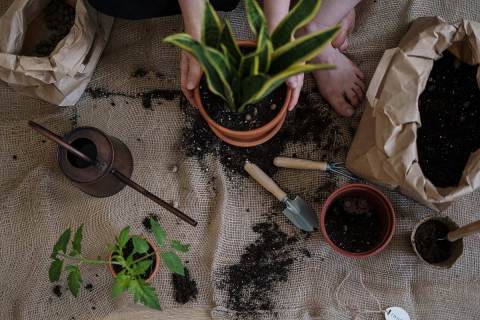
Houseplants are a popular feature in many of our homes, whether it’s sprucing up a windowsill or adding a pop of colour to the room, but research has shown there are far more wide-reaching benefits than just being decorative.
It’s not just the physiological benefits that houseplants have known to bring but also physical as shared by The Royal Horticultural Society. These benefits can include:
- Improved mood
- Help clean the air
- Reduced levels of stress
- Increased productivity
- Improvement in attention span
- Reduction in blood pressure
|
Image

|
Image

|
As National Gardening Week approaches (26th April – 2nd May ) it’s got us motivated to not just tend to our outside plants but our indoor ones too. Here’s our top tips to keep your houseplants looking their best and our top 3 easiest plants to grow indoors.
- The frequent watering that most houseplants require result in the soil loosing many of its nutrients. Regularly replacing the fertiliser can help replace the nutrients your plant needs and avoids attracting insects.
- Dust on leaves blocks the much-needed sunlight your houseplant relies on to survive. Use a damp cloth to remove thicker layers and frequently use a duster to keep any further dust at bay.
- Prune dead, brown, or yellowing leaves. If the leaf falls loose easily, remove it by hand.
- Whilst it’s easier to keep your indoor plants in the pot they came in, it’s important to allow them space to grow. If the roots need more room upgrade the plant to a bigger container.
- Check your plant’s environment to ensure it’s getting enough sunlight, it’s clear of any droughts and getting the right level of humidity. Advice on plant humidity.
|
|
Dragon Tree |
|
Rubber plants |
|
Boston Fern |
|
|
Image

|
Image

|
Image

|
||||
| Native to Madagascar the Dracaena marginata, more commonly known as “Dragon Tree” has vibrant green sword-like leaves with red tinges on the edges. This is one of the easiest indoor plans to grow and maintain. | There are many varieties of rubber plants with the most common in households being the Felastica decora which has shiny leather type leaves which can grow to a foot long. It can look great as a tablecentre piece of windowsill and once it gets above 3ft it works well next to door entrances or in the living room. | The Boston fern needs a cool environment with high humidity, indirect light and damp soil. These plants don’t require much fertilizer and once placed in the perfect spot in your home your Boston fern will thrive for many years to come. |




















